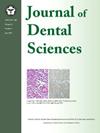在各类下颌骨缺损中使用双管血管化纤维皮瓣的优化设计
IF 3.4
3区 医学
Q1 DENTISTRY, ORAL SURGERY & MEDICINE
引用次数: 0
摘要
背景/目的采用带血管的双管游离腓骨瓣重建下颌骨,可以达到功能性和美观性的目的。本研究的目的是使用多种综合技术更有效地重建下颌骨,其中一些包含我们独特的想法。材料与方法本研究共纳入21例患者。术前获取患者下颌骨和腓骨的CT数据。采用计算机辅助手术模拟(CASS)技术进行个体化手术模拟,将约6种一体化的三维设计思想同时完美地转移到真实手术中。通过叠加下颌骨术后和术前图像,测量计划结果与实际结果之间地标的线性和角度偏差来评估重建的准确性。结果所有患者均能有效完成下颌骨重建,结果分析显示手术方案准确执行。术后患者面部轮廓协调,最大平均线差和角差分别为1.47±0.31 mm和3.97±0.63°。结论本研究系统阐述了应用带血管的双管游离腓骨瓣重建不同类型的下颌骨节段性缺损时如何选择和定位腓骨。为提高下颌骨缺损治疗的可及性和效率提供了有价值的指导。本文章由计算机程序翻译,如有差异,请以英文原文为准。
Optimized design for using of double-barrel vascularized fibular flap in various types of mandibular defects
Background/purpose
The functional and aesthetic reconstruction of the mandible can be achieved by using the double-barrel vascularized free fibula flap. The purpose of this study was to use multiple integrated techniques to more effectively reconstruct the mandible, some contains of our unique ideas.
Materials and methods
21 patients were included in this study. Computed tomography (CT) data of the patient's mandible and fibula were acquired preoperatively. Individualized surgical simulation was performed by using computer-aided surgical simulation (CASS) technology, about 6 kinds of integrated 3D design ideas were simultaneously perfectly transferred to real surgery. The accuracy of reconstruction was evaluated by superimposing the postoperative and preoperative image of mandible, measuring the linear and angular deviation of landmarks between the planned and actual outcomes.
Results
The mandibular reconstruction was effectively performed on all patients, and the result analysis showed that the surgical plan was precisely performed. The facial contours of the postoperative patients were harmonized and the largest mean linear and angular differences were 1.47 ± 0.31 mm and 3.97 ± 0.63°, respectively.
Conclusion
This study system illustrates how to select and position the fibula for reconstruction of various types of segmental mandibular defects by using double-barrel vascularized free fibula flap. It will provide valuable guidance and enhance the accessibility and efficiency of mandibular defects treatment.
求助全文
通过发布文献求助,成功后即可免费获取论文全文。
去求助
来源期刊

Journal of Dental Sciences
医学-牙科与口腔外科
CiteScore
5.10
自引率
14.30%
发文量
348
审稿时长
6 days
期刊介绍:
he Journal of Dental Sciences (JDS), published quarterly, is the official and open access publication of the Association for Dental Sciences of the Republic of China (ADS-ROC). The precedent journal of the JDS is the Chinese Dental Journal (CDJ) which had already been covered by MEDLINE in 1988. As the CDJ continued to prove its importance in the region, the ADS-ROC decided to move to the international community by publishing an English journal. Hence, the birth of the JDS in 2006. The JDS is indexed in the SCI Expanded since 2008. It is also indexed in Scopus, and EMCare, ScienceDirect, SIIC Data Bases.
The topics covered by the JDS include all fields of basic and clinical dentistry. Some manuscripts focusing on the study of certain endemic diseases such as dental caries and periodontal diseases in particular regions of any country as well as oral pre-cancers, oral cancers, and oral submucous fibrosis related to betel nut chewing habit are also considered for publication. Besides, the JDS also publishes articles about the efficacy of a new treatment modality on oral verrucous hyperplasia or early oral squamous cell carcinoma.
 求助内容:
求助内容: 应助结果提醒方式:
应助结果提醒方式:


